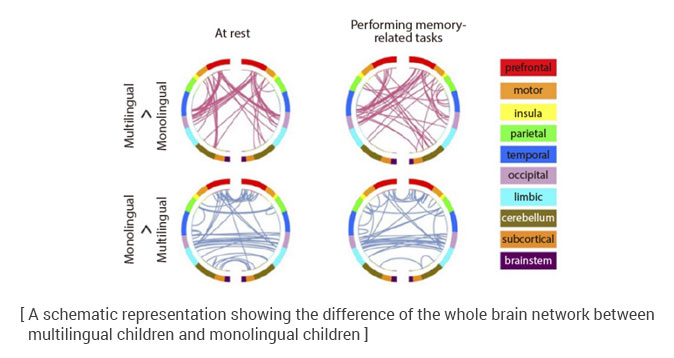Connectome-Based Technology for Predicting Multilingual Effects

The ‘whole brain network’ representing the pattern of connections between all the brain regions is referred to as connectome. Different people have different connectomes, as they incorporate the unique characteristics of individuals depending on their genetic background, age, intelligence and cognitive functions. Connectome is the basis of the research that was recently conducted by group of Professor Yong Jeong, the director of the KAIST Institute for Health Science and Technology. The research group conducted a joint study with Professor Marvin M. Chun’s group in Department of Psychology at Yale University to verify the differences of the connectome between multilingual and monolingual children. The research groups analyzed the Adolescent Brain Cognitive Development (ABCD) data from the US National Institutes of Health, including the cognitive function test results and the fMRI data from the children in the development stage at the ages of 9 to 10 years.
|Precious Priming Water for Research on Brain Diseases|
Differences of connectome were verified between multilingual and monolingual children.
The research group investigated the differences of the connectome between multilingual and monolingual children, and the results showed that the multilingual children had stronger connectivity in the occipital lobe and the subcortical regions when performing memory-related tasks. The pattern was clearly different between the two groups even at rest when they performed no task: strong connectivity was found between the occipital lobe and the prefrontal lobe in the multilingual children.
“We obtained the analytical results by controlling all socioeconomic factors, such as the economic status of the children’s families. Like the results obtained by analyzing the connectome, the cognitive test results showed the multilingual children had better performance than monolingual children, particularly in working-memory among various cognitive functions (working-memory, memory, self-control, spatial perception, etc.). When we inversely predicted multilingual or monolingual children based on the connectom analysis results, the predictive power was very high.”
Simply put, the results of the study showed that the multilingual children have better working-memory and their connectome have a more mature pattern, like that of adults, compared with the monolingual children. Does that suggest that multilingual children are superior to monolingual children? Director Jeong is taking precautions against a rash conclusion. “A child with good working-memory is likely to have good learning capabilities. However, does it always have positive impacts on the children in the long term to study better and become adults earlier, compared with their age?”
The study is likely to be extended to brain-related lesions.
One thing that is sure is that the results can contribute to various medical aspects. The study on multilingual effects can be extended to attention deficit hyperactivity disorder (ADHD) or autism or it may contribute to the treatment of degenerative brain diseases, including Alzheimer’s disease and Parkinson’s disease. “It is known that multilingual effects ultimately provide protective effects on patients with dementia. This is referred to as the ‘cognitive reserve’ of the brain, which I call ‘resilience to attack of diseases,’ the ability to tolerate or fight against a disease. We will be able to extend our study to these areas.”
Prof.Yong Jeong
2021 Annual Report
